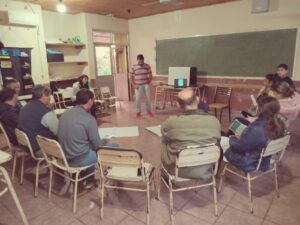Oga Project
Nideport continues to strengthen the relationship with local communities through participatory training and guidance projects to improve living conditions.
On Tuesday, July 12, the first activities of the OGA participatory housing project began. After the meetings and participatory diagnostics carried out during the last semester in the framework of the FPIC, where the Alecrín community prioritized to allocate time and skills to the project, the training stage began in the cycle of self-construction and maintenance of housing by the community. The first module of the inclusive labor training plan consists of the identification and generation of skills in the transportation, preparation, selection and stowage of the wood to be used in this project. In addition, some basic notions were provided on the correct handling and maintenance of the wood and on the safety and hygiene measures corresponding to the tasks performed.

OGA is a project that recognizes the habitat as an integral and articulating concept of the nande reko (or way of life) of the Mbya people and therefore, it constitutes the horizon of Nideport’s development interventions, including family and community food production, respect for the high natural, cultural and symbolic conservation values that make up the geo-existential space of Mbya life, the Tekoa (communal organization and territory of ancestral belonging).

An outstanding phase of the project is the improvement in the design of domestic spaces according to the characteristics of the community and the housing needs of the present, through the financing of materials for a housing module and training in construction and organization of solidarity and collaborative work.
The horizon of this project is the search for the generation of community benefits and a final impact based on the following dimensions and indicators:

Dimension 1: Overcrowding.
Indicators: A: number of rooms in the house. B: number of beds in the house. C: number of people living together in the oga (house).
Dimension 2: Precariousness of housing.
Indicators: A: housing materials. B: location of the kitchen. C: existence of bathroom in the house. D: flooding or leaks in the house. E: lack of adequate ventilation. F: lack of adequate heating. G: risk of fire.






